This post contains affiliate links, including links from the Amazon Associates programs. These links will direct you to products I recommend for further exploration and enjoyment of the topics I cover on my website and in my lectures. See more in the Privacy Policy below.
The centerpiece of our summer dinners is shashlik — Eastern Europe’s version of shish kebabs.
Shashlik is not just a recipe — it’s an institution, and a very male one at that. Eastern European men rarely rush into the kitchen to prepare meals, but with shashlik, they take over, shooing the lesser sex away from the process, declaring “shashlik doesn’t tolerate a woman’s touch.” They lord it over the “kostor” or grill and emerge with watery eyes flourishing sizzling meat impaled on skewers.
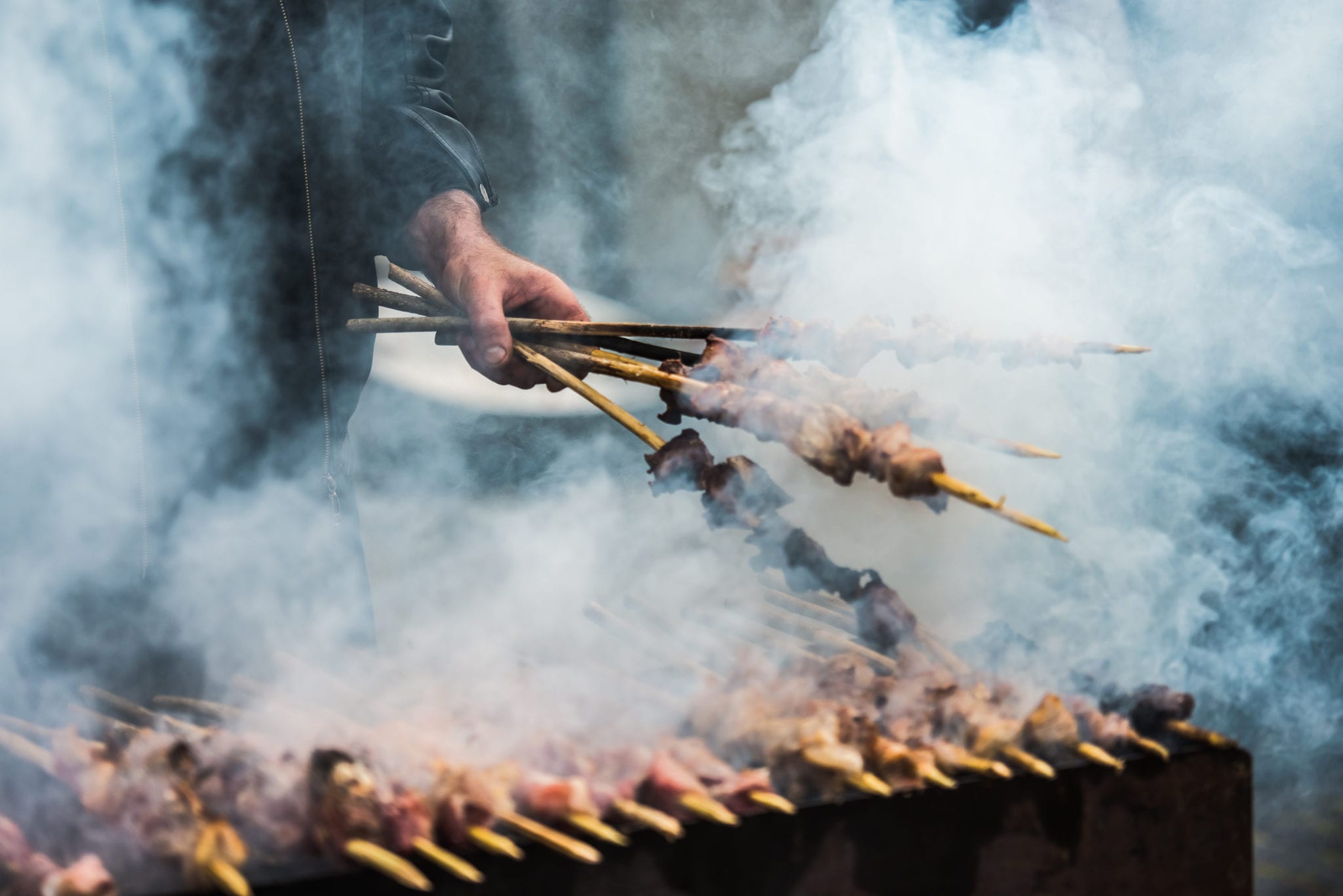
My Eastern European husband is no exception, though he graciously allows me to concoct the shashlik marinade. All he mashed to do is remove the meat from its long period of refrigeration, thread it onto a metal skewer and attend to the grill. Thanks to this division of labor, he has an excellent (if perhaps not wholly deserved) reputation as a master griller.
The Origins of Shashlik
Like spices and fermented foods, the Tatar Mongols brought barbecuing to Eastern Europe when they swept across the plains of Eurasia in the late 13th century. The Mongols forged a mighty empire, which stretched at its height from Poland to China. They lasted almost 250 years in Russia until Ivan the Great forced them out in the late 15th-century.
They left the shashlik though, and it has been enthusiastically incorporated into the cuisines of Eastern Europe, Central Asia, and notably the Caucuses, where it is a pillar of Georgia, Armenia and Azerbaijan’s delectable Caucasian cuisine.

“”Ivan III tears up the khans missive letter in front his ambassadors” by Aleksey Kivshenko
Shashlik Ingredients
The list of simple ingredients for shashlik is not long, but the emphasis really needs to be on quality. In the dacha villages I used to frequent when I lived in Russia, each dacha owner had long ago forged a relationship with a local farmer, which secured a steady supply of fresh meat for the kostor.
Shashlik can be made from beef, pork, poultry, game, and vegetables, but lamb and pork shashlik are the most commonly found versions.
Which Cuts of Meat?
Shashlik meat is normally cut into one to two-inch pieces or cubes.
Pork Shashlik
Pork shashlik can be made from any cuts of meat, from pork shoulder (Boston butt) to pork tenderloin. I prefer the shoulder as tenderloin can dry out quickly.
Beef Shashlik
I’ve tried several cuts of beef, but nothing beats the sirloin tips for flavor and texture.
Chicken Shashlik
Many people jump on chicken breasts for their shashlik, but a better option is to choose the dark meat: bone in thighs do very well on the grill, as do drumsticks, which look marvelous on the skewer.
Lamb Shashlik
Use the lamb loin for tender texture and the best flavor.
Fish Shashlik
Salmon does very well on the skewer, though it has a tendency to dry out. For best results, cure the salmon in advance: arrange the salmon cubes in a shallow, non-reactive baking dish. Sprinkle fine sea salt over the cubes of salmon, then sprinkle with finely chopped dill. Cover the pieces tightly with plastic wrap and refrigerate for 1-2 hours. Pat dry with paper towel. The salt breaks down the proteins, cutting down the amount of time is on the high heat.
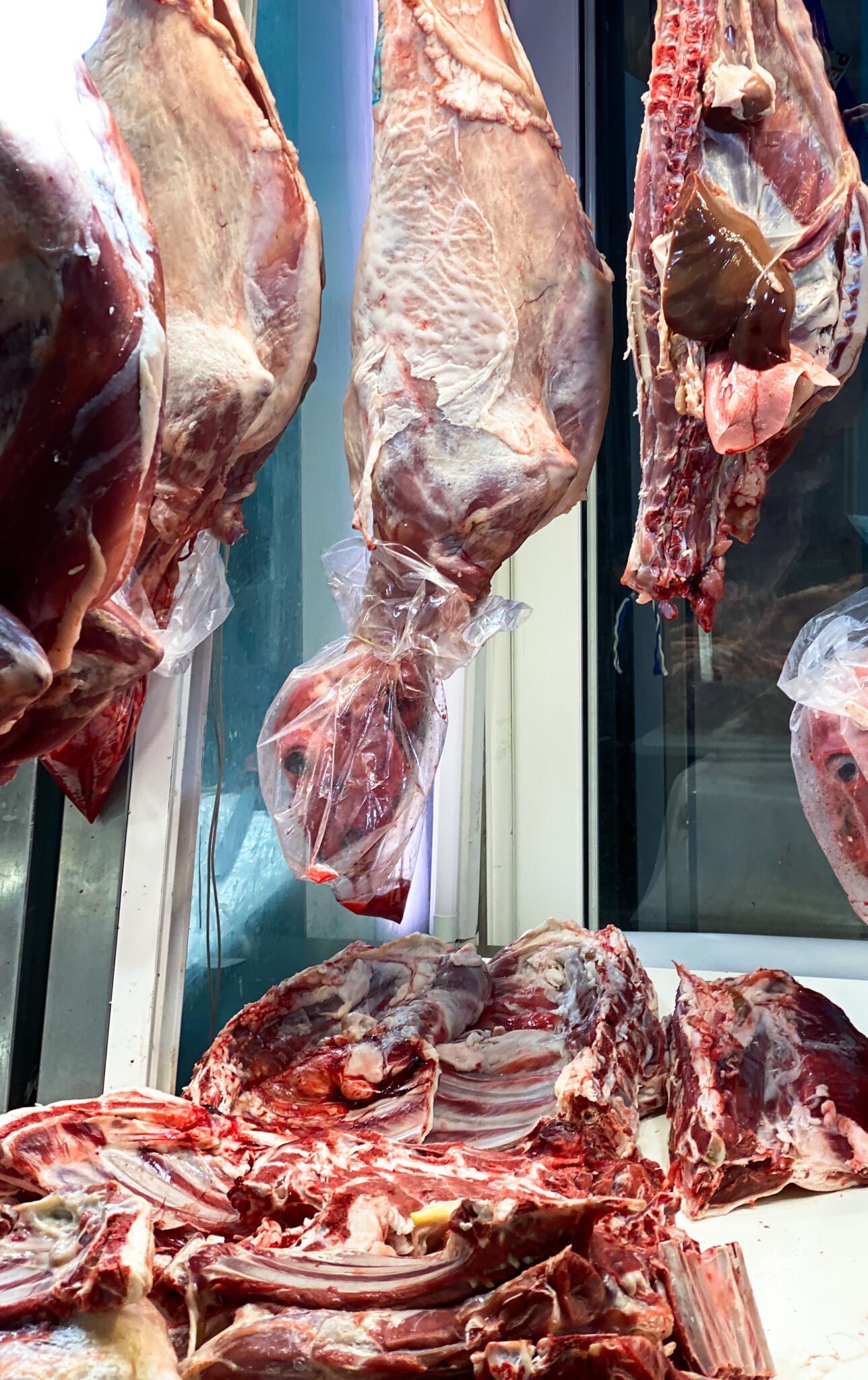
Photo Credit | Jennifer Eremeeva
Can you Make Vegetarian Shashlik?
I’m always conscious there might be vegetarians in the mix when I invite a crowd over, so I like to include a few vegetarian options.
- Corn on the cob goes very well on the skewer and pairs well with both chicken and salmon. For best results, cut the cob into 2-inch chunks, then blanch them in a large pot of well salted water. Allow them to come to room temperature before threading them on the skewer.
- Roasted beets take on a wonderfully smokey and sweet quality when roasted on the grill.
- Red bell peppers and red onions can be threaded with meat to enhance the flavor and appearance of the shashlik, as well grilled along with other crunchy vegetables as a purely vegetarian skewer.

Beet & Halloumi Cheese | Photo credit: Jennifer Eremeeva
Shashlik Marinade
The true secret to great shashlik is the marinade, which breaks down the proteins in the meat, making the cooking time far shorter, which ensures that the meat doesn’t dry out or get tough.
People often ask me what special equipment you need to make fantastic shashlik? Should they buy special wooden skewers? Do they need a turbo-charged gas grill? The answer is no. But you need one important piece of kit: the robust the Ziplock™ bag for the 12-24 hour bath in the key components of acid, salt, and spices. The marinade is like oil paints on the meat’s blank canvas. As Master of the Marinade, you imprint a unique combination of flavors onto the shashlik, along with that of the wood smoke and fresh air of the country.
Marinade Ingredients
Acid
When marinating lamb, beef, and game, dry red wine and red wine vinegar will imprint a lovely flavor and produce very juicy meat.
Chicken, Turkey, and pork will respond well to white wine and and fresh lemon juice, but be sure to dilute the citrus so that it doesn’t start cooking the chicken. Citrus zest is also a great addition to any marinade for any meat.
Consider as well fermented dairy products such as sour cream, yogurt, kefir, buttermilk, or whey (the by-product of making yogurt). Kefir is particularly good with pork.
Adding some “rasol’” or the brine from pickled vegetables, gherkins, olives or cornishons gives the meat a nice briny flavor.
Salt
Salt is the workhorse of the kitchen, and essential to breaking down the proteins in the meat, making it tender and juicy. It also enhances the flavor. Consider other salty condiments you may have lying around your pantry: mustard, ketchup, hot sauce, soy sauce, or bottled salad dressing. This can be a great way to use up some of the soon-to-be-past-their-sale-by-date bottle lurking in your refrigerator.
Herbs, Spices, and Alliums
Now comes the fun part: concocting the marinade, which you can do in the food processor, or just fill a large clean glass jar with the ingredients and shake vigorously to combine.
Smashed garlic cloves, sliced onions, wild garlic, chives, and scallions add a lovely flavor note to shashlik.
Inject an umami bomb into lamb and game marinades with the addition of a few tinned anchovies, or several dashes of Worcestershire Sauce or Asian Fish sauce. Do the same with beef, using tomato paste or Gochujang (Korean red chili paste).
The addition of herbs and spices is where you really make the marinade your own. Be creative and use what you have lying around.
Rosemary and thyme go well with lamb, bay leaf, and sweet red and black pepper with beef, basil and tarragon for chicken, and dill for fish. This is also a great time to experiment with the more exotic jars in your pantry: sumac, cumin, garam masala, and summer savory will all make the marinade really sing, as will some Georgian Svanetian Salt.
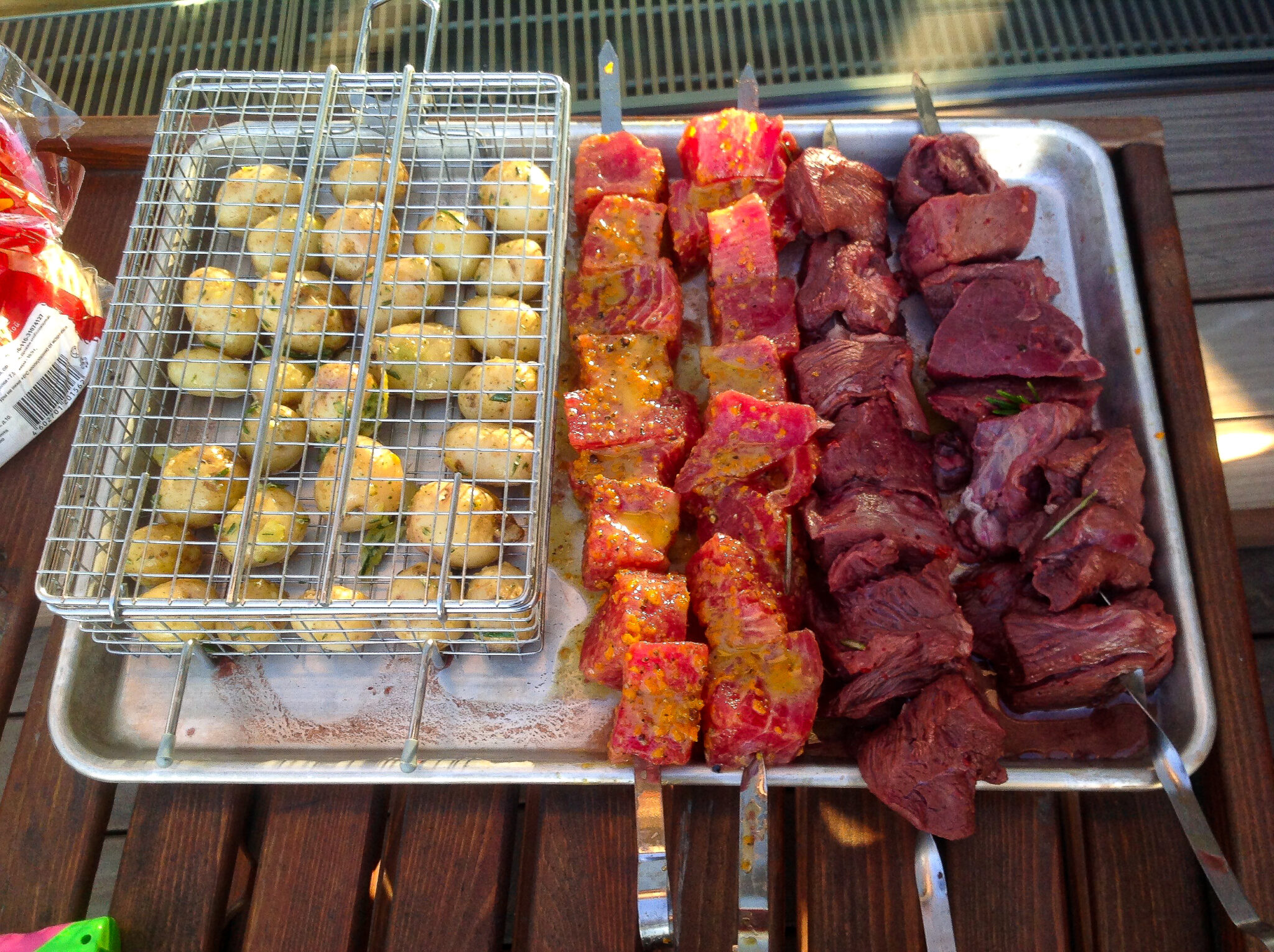
Photo Credit | Jennifer Eremeeva
What Kinds of Skewers to use for Shashlik?
Classic shashlik is skewered onto sturdy metal skewers that are about 18” – 23” inches. These are reusable and an excellent option if you are grilling over an open fire or wood coals. I use these skewers, which are really easy to clean — often the most labor intensive aspect of making shashlik.
Recyclable bamboo or wooden skewers will also work well, but must be soaked overnight in salt water to ensure that they don’t burn when they come into contact with the heat of the grill.
How to Grill Shashlik
Serious shashlik grillers use a folding metal box called a mangal to grill shashlik, which is great for camping. A wood fire is set in the mangal several hours before grilling time, and allowed to burn down to wood coals. Lay the skewers across the box (see below) and turn them every 2-3 minutes until the meat reaches the desired doneness.
A few hours before you are ready to grill, get the meat out of the refrigerator and bring it to room temperature. Pour off the marinade (or save it if the recipe calls to serve the shashlik with it). Pat the meat dry with paper towels and thread it onto the shashlik skewers. Place the skewers on the mangal, gas grill, or under your oven’s broiler and grill for about 15-20 minutes, turning each 2-3 minutes to ensure the meat is cooked evenly. Note the recommended minimum internal temperatures: beef, lamb, and pork should be at least 145°F (62.8°C) and poultry should be at least 165°F (73.9°C). If you plan on being a regular griller, invest in an instant-read thermometer to be sure the meat has reached the correct temperature.
Tent the meat with tin foil for 3 minutes to allow the juices to go back into the meat, and serve to your impressed guests!
Classic Eastern European Lamb Shashlik
Classic Eastern European Shashlik
Equipment
Ingredients
- 1 kilo of pork or lamb cubed
- 2 yellow onions cut into 1/8 half moons
- 1 cup of red wine vinegar
- cold water
- The juice of one lemon and/or 12 cups of fresh pomegranate juice
- Chopped fresh parsley
- 5 sprigs of dill
- 4 Tbls of peppercorns coarsely crushed in a mortar and pestle
- 4 Tbls of coarse sea salt
- 4 scallions diced
- 4 cloves of garlic crushed
- 1/8 cup of fresh coriander
- ½ a cup of olive oil
Instructions
- Trim the meat of all fat, and cut into 5 cm cubes.
- Place the meat in an airtight wide dish with a lid. Combine the rest of the ingredients except for the onion, olive oil, coriander and the water together in a jar and combine by shaking vigorously. Pour the marinade on top of the meat, using water to top up so that the meat is covered.
- Refrigerate, covered overnight, or, if you are in a hurry, let stand at room temperature. Toss the meat at intervals, making sure that all the pieces are well marinated.
- Using long skewers, spear the meat cubes and onions in a pattern of your choosing. Grill the skewers until the meat is browned and the juices run pink. Turn frequently, and baste with the olive oil. Serve immediately garnished with the chopped fresh coriander.
Other Shashlik Recipes
Expand your shashlik repertoire as you enjoy these recipes for shashlik and sides!
Shashlik Sauces
There are so many things to serve with shashlik. When I first came to Russia, ketchup was still a big deal, so everyone had that, which I found very depressing. Get those large plastic bottles OFF the table! There are so many other condiments that work better.
I always prefer the sauces of Caucasian cuisine such as Tkemali (a sour plum sauce) or Adzhika, a spicy condiment that originates with the shepherds of the mountains in Georgia. Or you could try some of the condiments from South Asia, such as Sweet Chili Sauce or Thai Chili Sriracha.
You can also rummage around your fridge and pantry to come up with your own shashlik sauces. Here are a few I turn to when I’m out of the exotic stuff.
- Swirl mayonnaise and ketchup together with a teaspoon of horseradish and a dash of vodka for a cocktail sauce.
- Add the juice of 2 medium lemons, garlic cloves, fresh herbs, dry dill weed, and a large Tablespoon of Dijon mustard to Greek yogurt or sour cream
- Mash 1 Tbls of capers in ⅓-cup of mayonnaise with chopped fresh herbs and a spritz of lemon juice
- Combine ⅓-cup of chopped herbs (dill, oregano, mint, basil etc.) with ⅓ cup of mild olive oil and the juice and zest of one lemon.
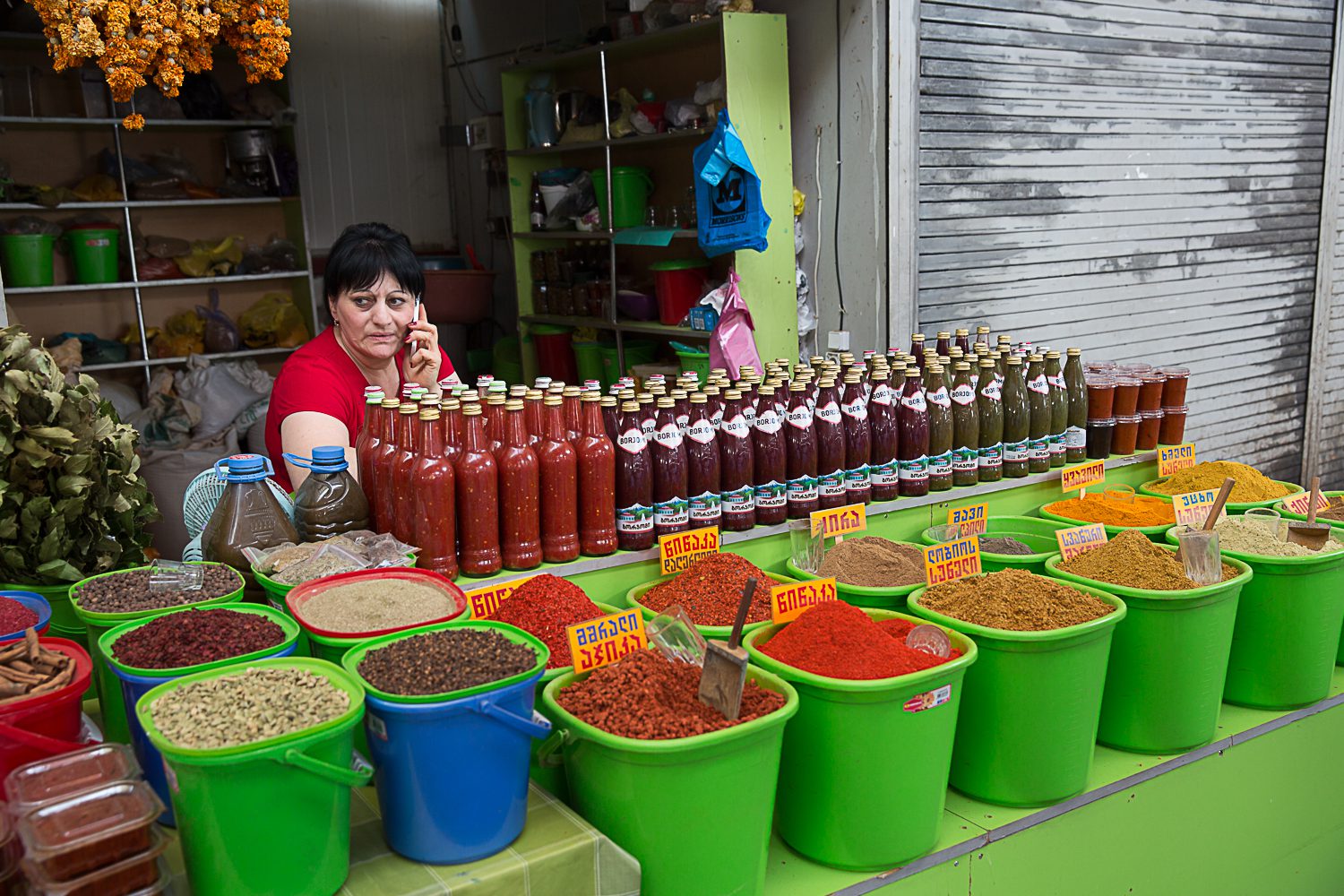

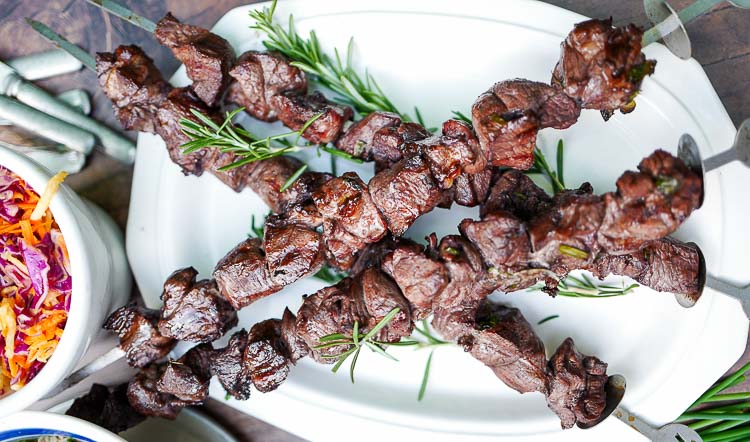
Great shashlik recipes! I love juniper berries, and have never thought of using them for shashlik. And I’ve never heard of anchovy paste for lamb shashlik, sounds interesting, will have the try it! Thanks for posting! Love your blog
Peter,
Try putting juniper berries in a gin and tonic….you’ll thank me!
Jennifer
Great idea, Thanks for that, I’ll try it! During Christmas, I put them in a pestle and mortar with peppercorns, smash them all to death and use them my turkey gravy as seasoning. Adds a great zing! 🙂
I just posted a recipe for a sweet Kumquat Nastoyka (настойка), but I wonder what I can concoct with Juniper berries…… ideas ideas….. Thanks!
Peter
Thanks For Sharing this amazing recipe. My family loved it. I will be sharing this recipe with my friends. Hope the will like it.